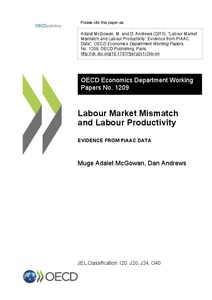Labour market mismatch and labour productivity: evidence from PIAAC data
"This paper explores the link between skill and qualification mismatch and labour productivity using cross-country industry data for 19 OECD countries. Utilising mismatch indicators aggregated from micro-data sourced from the recent OECD Survey of Adult Skills (PIAAC), the main results suggest...
| Main Authors: | , |
|---|---|
| Institution: | ETUI-European Trade Union Institute |
| Format: | TEXT |
| Language: | English |
| Published: |
Paris
2015
OECD |
| Subjects: | |
| Online Access: | https://www.labourline.org/KENTIKA-19112840124919300229-Labour-market-mismatch-and-lab.htm |
| Summary: | "This paper explores the link between skill and qualification mismatch and labour productivity using cross-country industry data for 19 OECD countries. Utilising mismatch indicators aggregated from micro-data sourced from the recent OECD Survey of Adult Skills (PIAAC), the main results suggest that higher skill and qualification mismatch is associated with lower labour productivity, with over-skilling and under-qualification accounting for most of these impacts. A novel result is that higher skill mismatch is associated with lower labour productivity through a less efficient allocation of resources, presumably because when the share of over-skilled workers is higher, more productive firms find it more difficult to attract skilled labour and gain market shares at the expense of less productive firms. At the same time, a higher share of under-qualified workers is associated with both lower allocative efficiency and within-firm productivity – i.e. a lower ratio of high productivity to low productivity firms. While differences in managerial quality can potentially account for the relationship between mismatch and within-firm productivity, the paper offers some preliminary insights into the policy factors that might explain the link between skill mismatch and resource allocation." |
|---|---|
| Physical Description: | 50 p. Digital |

